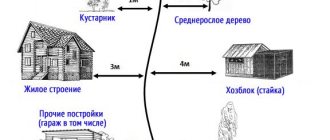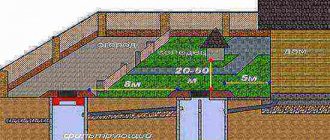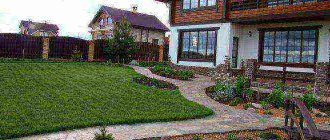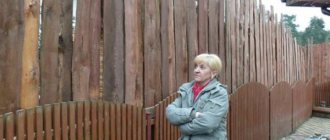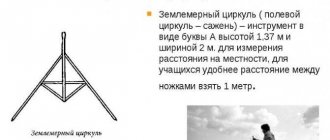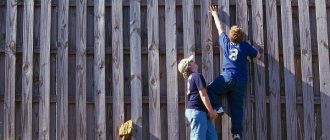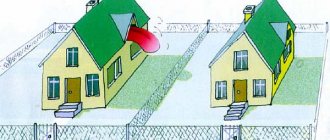The area behind the fence of a private house is called the adjacent territory and is a public area. Often, local authorities literally force owners and tenants to monitor it, mow the grass and clean it up, threatening them with fines. Where such requirements are prescribed, as well as how many meters from the fence the territory must be cleaned by law in a private house, in organizations (in a kindergarten, in a school) we will look in more detail.
Rights to the territory behind the fence and obligations to clean the adjacent territory according to the law
What rights do we have to the territory behind the fence and what are our responsibilities under the law?
In order to find out whether it is necessary to clean and mow the area near the fence and for how many meters, let’s turn to the current legislation.
In accordance with the Town Planning Code of the Russian Federation (clause 37 of Article 1), the adjacent territory is a public area that is adjacent to a building, structure, or land plot that is formed and is registered in the cadastral register. In this case, the boundaries of the adjacent territory are determined by the rules of improvement adopted in the municipality in accordance with the legal norms of the subject on whose territory this formation is located.
We conclude that the area from the fence must be cleared as many meters as established by local authorities. This means that we need to turn to local acts. At the same time, it would not hurt to study the laws of the subject, so that local authorities do not exceed their powers and demand more.
The Civil Code (clause 9 of Article 55.25) states that persons responsible for the operation of buildings MUST take a direct part, including financial participation, in maintaining the surrounding areas in order.
Law No. 131-FZ of October 6, 2003 (as amended in December 2019) “On Local Self-Government” also obliges owners of land plots and buildings to maintain adjacent territories in order, including in the form of financing such an order. (Article 45.1).
This obligation does not apply to owners of high-rise apartments. (If you are interested in details about the rules for using the adjacent territory of an apartment building, read here).
Thus, having become the owner of a plot of land, we a priori agree to monitor the adjacent territory, clean it, and, if necessary, mow the grass.
What rights do we have to this territory? We cannot fence it off, since it is public property. We have exactly the same rights to it as all other persons - rights of general use. Compared to the responsibilities, it’s not a lot. (Read more about the rights and obligations to the territory behind the fence of a private house here.)
Now let’s begin to study the most important question: who determines the footage of the adjacent territory and how many meters from the fence it needs to be removed.
What is included in the list of works to restore order?
The management company does not have the right to perform cleaning at its own discretion. There are specific norms and rules in this regard, prescribed at the legislative level.
The main list of works that must be implemented:
maintaining the cleanliness of sidewalks, roads, lawns, pedestrian areas;- removal of snow from the local area;
- maintaining the cleanliness and functionality of all elements installed in the local area;
- ensuring access to hatches, engineering units, water supply points - the presence of debris on them or their icing is unacceptable;
- caring for green spaces and keeping them clean;
- daily cleaning of bins with their scheduled disinfection;
- Maintaining cleanliness of waste collection areas.
If necessary, HOAs must use specialized equipment.
The area behind the fence of a private house - at what distance should it be kept clean?
Laws at the federal level give general concepts of maintaining the territory in order, but no specifics. In order to find out how many meters from the fence of a private house you need to remove, you should refer to local regulations.
Local rules and decisions contain more specific information; in addition, they should not contradict the law of the subject in whose territory they are located.
For example , your private house is located on the territory of the municipality of Podolsk, Moscow region.
In the Moscow region, the rules for improvement were approved by the Law on Improvement dated December 30, 2014 No. 191/2014-OZ; in Podolsk the rules were enshrined in the Decision of the Council of Deputies dated December 28, 2018 No. 56/13. These two acts practically duplicate each other, except that the decision contains additions regarding local features.
Local Laws and acts define a number of minimum responsibilities for keeping the area outside the fence of a private house clean and tidy, namely:
- mow lawns and other grassy vegetation;
- maintain outdoor utility equipment;
- remove garbage from the area behind the fence;
- maintain the pedestrian road surface in order;
- carry out snow removal;
- do not allow storage of fuel, building materials, fertilizers in the adjacent territory for more than 7 days.
What area in a private house behind the fence needs to be kept clean and in order?
Also, the landscaping rules for the region indicate the specific size of adjacent territories for private owners:
In relation to land plots and territories of individual households - NO MORE than 5 meters from the boundaries of such plots and possessions.
In relation to SNT - NO LESS THAN 5 meters and NO MORE THAN 30 meters of territory behind the fence.
As for dacha plots in SNT, here we are talking about a public territory and rules for footage are established regarding the boundaries of the SNT itself.
Accordingly, the charter of a gardening partnership may stipulate rules for cleaning the area behind the fence of a private house on your site within this area.
But what if the adjacent territory belongs to both one building and another? For example, the area between the fences of two private houses is only 5 meters. How many meters from the fence will need to be removed then? In this case, the adjacent territories are suppressed, and it is divided equitably - half is removed by one owner, and half by the other. At least, according to the law of the Moscow region, such rules apply.
Attention! In your region, the area that must be cleaned outside the fence of your property is regulated by the rules of the local administration and may differ from the example above.
What it is?
The local area is the space that belongs to a particular house. Its boundaries are fixed at the stage of construction of a residential property.
You can find out exactly how many meters are included in the local area of a house at a specific address from the cadastral documentation. Another option is to submit a request to the State Register.
The local area includes such objects as:
flower beds, shrubs and other landscaping elements;- benches and gazebos;
- sport complexes;
- parking spaces for vehicles;
- alleys and sidewalks;
- pedestrian paths;
- lanterns and other lighting elements;
- areas where waste bins are located.
In some local areas there is a complete list of objects, while in others there are only a few of the most significant elements.
How many meters from the fence does the organization’s territory need to be cleaned?
If everything is more or less clear with cleaning the areas behind the fence of private houses - it falls on the shoulders of the owner, then with cleaning the adjacent territories of legal entities, things are more complicated. Janitors are hired for cleaning and payment directly depends on the amount of work.
For example, how many meters from the fence do you need to clean the area in a kindergarten or school? Perhaps there are some standards for organizations? The standards really exist and they are all contained in the same acts of local authorities. In an amicable way, city authorities should develop a scheme for cleaning up the areas. At the same time, owners and persons responsible for the operation of buildings must be familiar with it. But such schemes have not been developed everywhere. In addition, due to the continuity of cadastral registration (preparation of new technical plans, boundary plans, land surveying) and updating of Rosreestr data, such schemes may become outdated.
Typically, organizations clean the area behind their fence (or around the building, if there is no fence as such), mow the grass, take care of the bushes, clear the snow, according to already established rules.
In fact, this adjacent area can reach 30 meters - again, everything is individual and depends on the landscaping rules established in your area. Most often, the adjacent territory of organizations ends where the curbs of the roadway or neighboring home areas begin.
Cost of services
The cost of cleaning a local area depends on a number of factors, including:
Regional affiliation. In each subject of the Russian Federation, an average price is unofficially established, which is the guideline for all companies and individuals.- Season. Cleaning costs less in summer than in winter.
- Scope of upcoming work. The larger it is, the more expensive the services of specialists will cost.
- Time and effort spent on cleaning. Naturally, removing snow 0.5 m thick is much more difficult than sweeping a footpath.
- Service level. Large companies employ trained people, they have technological equipment that allows them to carry out cleaning in the shortest possible time and with the highest quality.
- Current promotions and discounts. They can be offered by serious organizations.
Estimated cost depending on the time of year: in winter - from 15 rubles per sq. m. m., in summer - from 12 rubles per sq. m.
Responsibility and fines for violation of landscaping
We found out who should clean the adjacent territory - the owners or persons representing them. What will happen if you do not comply with the instructions of the authorities and refuse to clean and maintain public places? After all, in fact, these are municipal lands, which means the authorities must monitor them at the expense of the budget.
Many people think this way, but this opinion is wrong. The authorities really need to keep order locally, including on the streets. And at whose expense is a moot point. Moreover, federal laws directly stipulate that the owners of adjacent territories must take a financial part in their cleaning. If you want to live in a private house, buy a lawn mower, a shovel and go ahead – improve your plot and everything around it.
But no one has the right to immediately fine the owner for non-compliance with the rules of landscaping without an appropriate order. First there must be an act of warning - an order (decree, presentation, decision), and if there is no reaction - then a physical fine. individuals up to 500 rubles, and organizations up to 20 thousand rubles (Article 19.5 of the Administrative Code). However, paying a fine does not relieve you from the obligation to clean the adjacent territory.
So, ownership of land and real estate is not only rights, but also responsibilities, and the range of these responsibilities can be much wider than we imagine. But there is no need to criticize the legislation. We must consciously approach public property, because it is much more pleasant to see clean streets around us, and to understand that each of us makes our own contribution to this cleanliness. It is better not to seek instructions, but to do everything on time.

